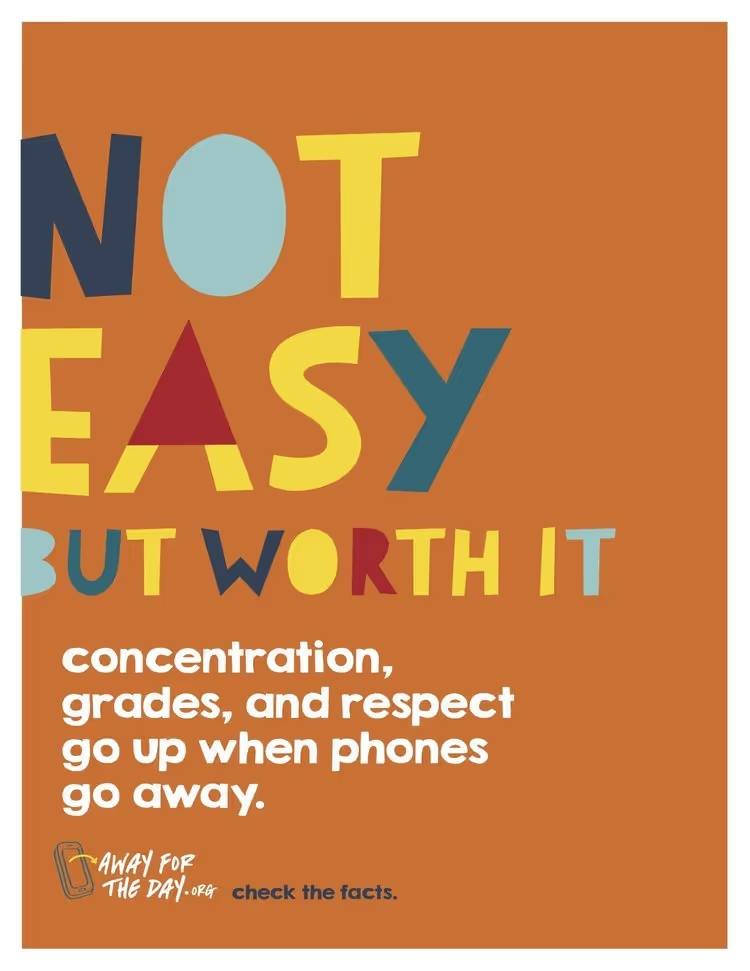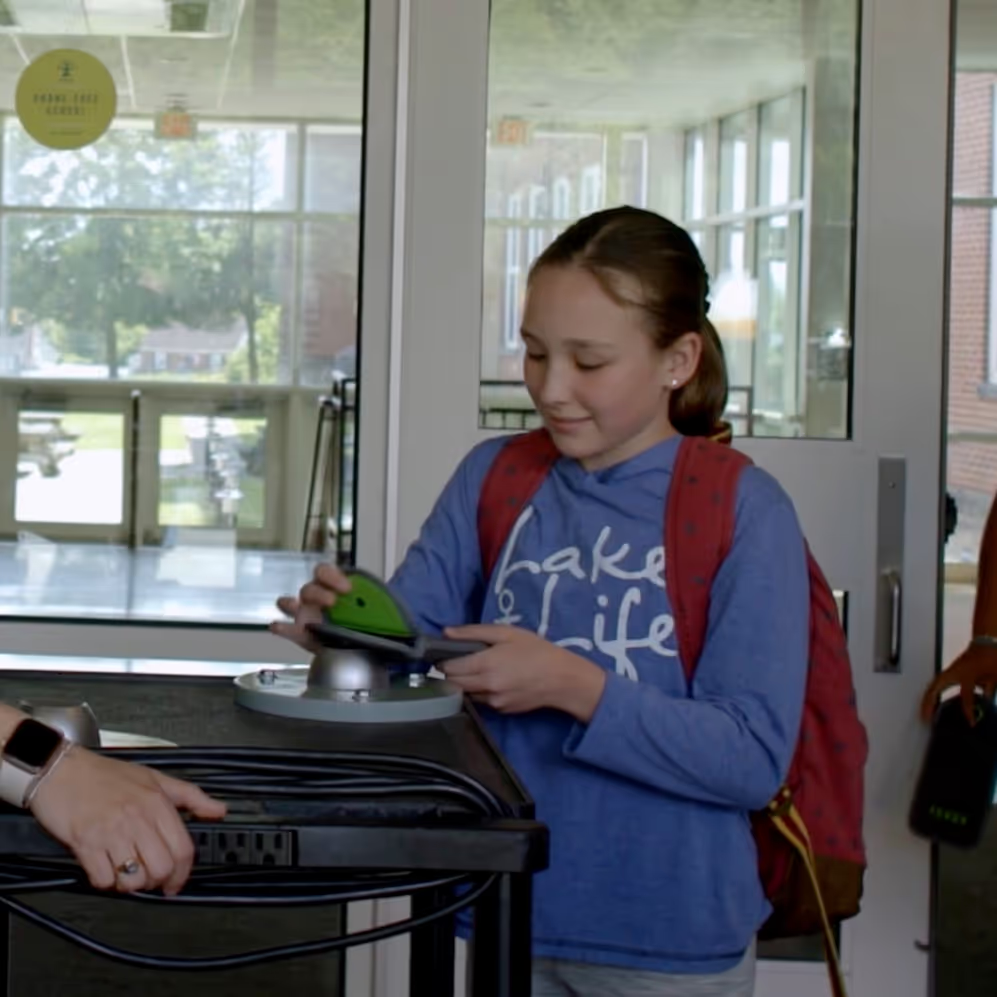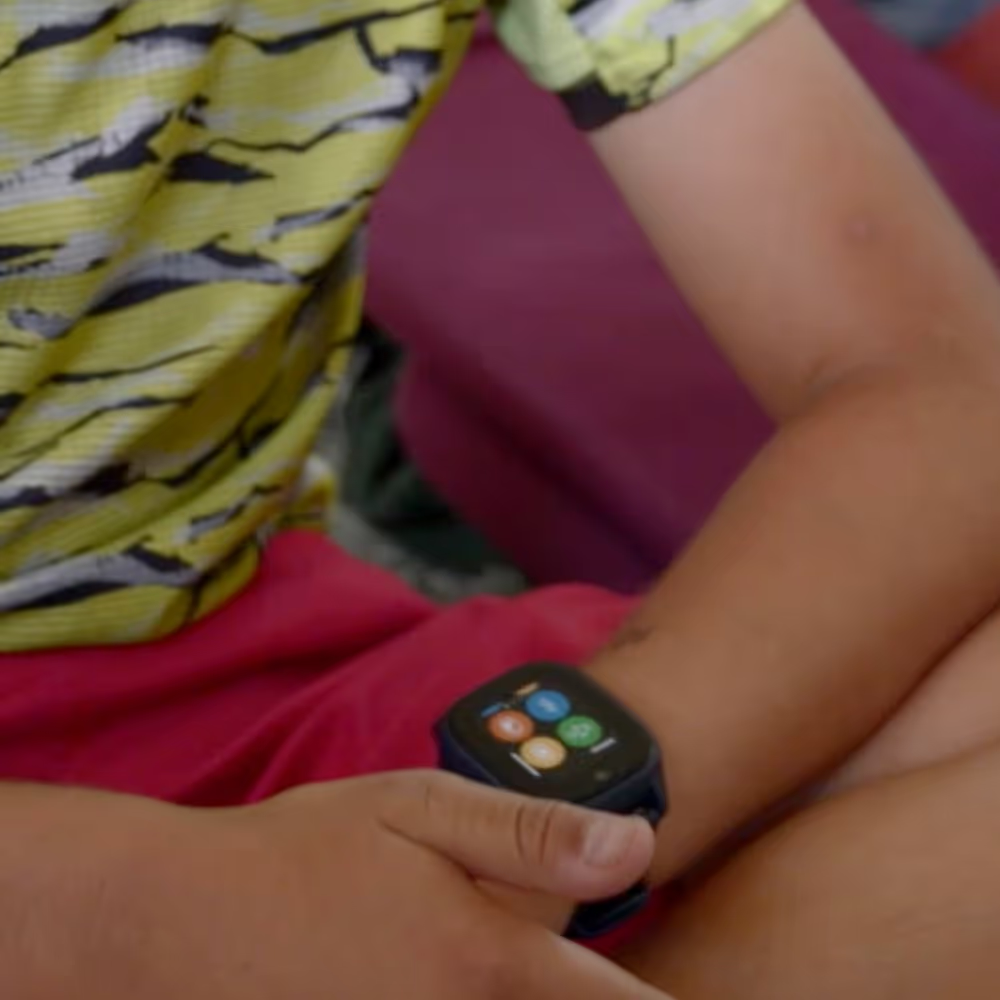


First, I want to thank so many of you for reaching out upon hearing last week about my latest film, Screenagers NEXT CHAPTER. It is fantastic to hear how many of you are organizing screenings or going to our website to find one near you. As we look at challenging emotions facing today's teens, Away For The Day is spotlighted in the movie. What is Away For the Day? Well, now that you asked...
In December 2017, my co-producer, Lisa, and I launched the Away For The Day campaign to have phones put away in lockers during school. The movement gives parents, teachers, and school leaders action tools they can use at their school to institute cell phone free policies. The tools include research papers, video testimonials, and examples of cell phone free policies used in other schools.
I am excited to give some really important updates on how the movement is going, but first a bit of background in case you are not aware of the movement.
Tech provides many educational tools — no question whatsoever. But having, in particular, elementary and middle school students carrying around their own phones chock-full of video games and social media is not the same as carrying around a purely designated educational tool. That is where the concern comes in. (Have designated tech for learning — cell phones are not that).
Cell phones in schools do much more than take away from academic learning and face-to-face interactions. They can also be the source of hard emotional hits. If students have their phones in their pocket in class, they may sneak a peek at their social feeds and see pictures of friends doing fun things without them; or maybe they didn't get many likes on a post. They may feel anxious a SnapChat wasn't opened. Young people who are in a low-emotional state are particularly vulnerable to the emotional hits happening all day long when they have access to their phones in school.
Recently, many of you have reached out to tell us about how our Away For The Day resources have helped change policies in your schools.
At San Mateo High School outside of San Francisco, students are now required to lock their phones away in special pouches (called Yondr) for the day. The assistant principal, Andrew Gelb, told an ABC TV reporter,
"Now the average bathroom break is probably two-to-three minutes, whereas last year it was 20-30 minutes and we just had students wandering the halls with their head down on their phones."
A father in Portola Valley, California just told us how he's been using the research and resources to help influence his son's high school. One thing he found useful in furthering the conversation was to survey the parents to determine their cell phone policy preferences. He has generously shared this survey template for our readers.
An assistant principal at West Middle School in Michigan shared with us that after allowing phones in her middle school for the last three years, they are changing their policies.
"We are using a ton of research from your website. I absolutely loved the posters. I am going to get them printed in color for our building. I also really liked seeing the different policies and consequences," she told me. "My staff is very used to letting kids use their phones for classroom activities and this is going to be hard for them to make the change… but it's totally worth it." Here is what their new policy states:
WMS recognizes the importance of communication and collaboration, and provides devices for students to be productive in the classroom. To keep the focus on academics and to reduce unnecessary distractions, the school will be enforcing the following:
West Middle School Consequences and Family Communication:
Students using phones or electronic devices without authorization:
When we did our last survey, more than half of the middle schools in the United States allow students to carry their phones. But we can't just leave it to the school principals, teachers, and PTA to change that; parents have to get involved so that the no-phone policies become the norm.
The good news is that the majority of parents support what the science shows: that for academic success and emotional well-being, having cell phones put away for the day in middle school is really the way to go.
And things continue to improve. According to an article in Education Week, "California recently passed legislation that allows school districts to restrict or prohibit device use in class, although it's not a requirement. And at least four other states debated putting significant limits on the devices."
*We would love for you to share this TTT any way that works for you, whether that’s on social media or via a newsletter. If you want to send it out in your newsletter we just ask that you credit us and link to our website, and let us know at lisa@screenagersmovie.com.
HOST A SCREENING to help spark change.
FIND EVENT LISTINGS
Do you organize professional development in schools? We now have a 6-hour, 3-part training module. Request more information here Professional Development.
Stay in touch with the Screenagers community on Facebook, Twitter and leave comments below.
Learn more about showing our movies in your school or community!
Join Screenagers filmmaker Delaney Ruston MD for our latest Podcast

Learn more about our Screen-Free Sleep campaign at the website!
Our movie made for parents and educators of younger kids
Learn more about showing our movies in your school or community!
Learn more about showing our movies in your school or community!
Join Screenagers filmmaker Delaney Ruston MD for our latest Podcast

Learn more about our Screen-Free Sleep campaign at the website!
Our movie made for parents and educators of younger kids
Join Screenagers filmmaker Delaney Ruston MD for our latest Podcast
As we’re about to celebrate 10 years of Screenagers, we want to hear what’s been most helpful and what you’d like to see next.
Please click here to share your thoughts with us in our community survey. It only takes 5–10 minutes, and everyone who completes it will be entered to win one of five $50 Amazon vouchers.
First, I want to thank so many of you for reaching out upon hearing last week about my latest film, Screenagers NEXT CHAPTER. It is fantastic to hear how many of you are organizing screenings or going to our website to find one near you. As we look at challenging emotions facing today's teens, Away For The Day is spotlighted in the movie. What is Away For the Day? Well, now that you asked...
In December 2017, my co-producer, Lisa, and I launched the Away For The Day campaign to have phones put away in lockers during school. The movement gives parents, teachers, and school leaders action tools they can use at their school to institute cell phone free policies. The tools include research papers, video testimonials, and examples of cell phone free policies used in other schools.
I am excited to give some really important updates on how the movement is going, but first a bit of background in case you are not aware of the movement.
Tech provides many educational tools — no question whatsoever. But having, in particular, elementary and middle school students carrying around their own phones chock-full of video games and social media is not the same as carrying around a purely designated educational tool. That is where the concern comes in. (Have designated tech for learning — cell phones are not that).
Cell phones in schools do much more than take away from academic learning and face-to-face interactions. They can also be the source of hard emotional hits. If students have their phones in their pocket in class, they may sneak a peek at their social feeds and see pictures of friends doing fun things without them; or maybe they didn't get many likes on a post. They may feel anxious a SnapChat wasn't opened. Young people who are in a low-emotional state are particularly vulnerable to the emotional hits happening all day long when they have access to their phones in school.
Recently, many of you have reached out to tell us about how our Away For The Day resources have helped change policies in your schools.
At San Mateo High School outside of San Francisco, students are now required to lock their phones away in special pouches (called Yondr) for the day. The assistant principal, Andrew Gelb, told an ABC TV reporter,
"Now the average bathroom break is probably two-to-three minutes, whereas last year it was 20-30 minutes and we just had students wandering the halls with their head down on their phones."
A father in Portola Valley, California just told us how he's been using the research and resources to help influence his son's high school. One thing he found useful in furthering the conversation was to survey the parents to determine their cell phone policy preferences. He has generously shared this survey template for our readers.
An assistant principal at West Middle School in Michigan shared with us that after allowing phones in her middle school for the last three years, they are changing their policies.
"We are using a ton of research from your website. I absolutely loved the posters. I am going to get them printed in color for our building. I also really liked seeing the different policies and consequences," she told me. "My staff is very used to letting kids use their phones for classroom activities and this is going to be hard for them to make the change… but it's totally worth it." Here is what their new policy states:
WMS recognizes the importance of communication and collaboration, and provides devices for students to be productive in the classroom. To keep the focus on academics and to reduce unnecessary distractions, the school will be enforcing the following:
West Middle School Consequences and Family Communication:
Students using phones or electronic devices without authorization:
When we did our last survey, more than half of the middle schools in the United States allow students to carry their phones. But we can't just leave it to the school principals, teachers, and PTA to change that; parents have to get involved so that the no-phone policies become the norm.
The good news is that the majority of parents support what the science shows: that for academic success and emotional well-being, having cell phones put away for the day in middle school is really the way to go.
And things continue to improve. According to an article in Education Week, "California recently passed legislation that allows school districts to restrict or prohibit device use in class, although it's not a requirement. And at least four other states debated putting significant limits on the devices."
*We would love for you to share this TTT any way that works for you, whether that’s on social media or via a newsletter. If you want to send it out in your newsletter we just ask that you credit us and link to our website, and let us know at lisa@screenagersmovie.com.
HOST A SCREENING to help spark change.
FIND EVENT LISTINGS
Do you organize professional development in schools? We now have a 6-hour, 3-part training module. Request more information here Professional Development.
Stay in touch with the Screenagers community on Facebook, Twitter and leave comments below.
Sign up here to receive the weekly Tech Talk Tuesdays newsletter from Screenagers filmmaker Delaney Ruston MD.
We respect your privacy.
First, I want to thank so many of you for reaching out upon hearing last week about my latest film, Screenagers NEXT CHAPTER. It is fantastic to hear how many of you are organizing screenings or going to our website to find one near you. As we look at challenging emotions facing today's teens, Away For The Day is spotlighted in the movie. What is Away For the Day? Well, now that you asked...
In December 2017, my co-producer, Lisa, and I launched the Away For The Day campaign to have phones put away in lockers during school. The movement gives parents, teachers, and school leaders action tools they can use at their school to institute cell phone free policies. The tools include research papers, video testimonials, and examples of cell phone free policies used in other schools.
I am excited to give some really important updates on how the movement is going, but first a bit of background in case you are not aware of the movement.
Tech provides many educational tools — no question whatsoever. But having, in particular, elementary and middle school students carrying around their own phones chock-full of video games and social media is not the same as carrying around a purely designated educational tool. That is where the concern comes in. (Have designated tech for learning — cell phones are not that).
Cell phones in schools do much more than take away from academic learning and face-to-face interactions. They can also be the source of hard emotional hits. If students have their phones in their pocket in class, they may sneak a peek at their social feeds and see pictures of friends doing fun things without them; or maybe they didn't get many likes on a post. They may feel anxious a SnapChat wasn't opened. Young people who are in a low-emotional state are particularly vulnerable to the emotional hits happening all day long when they have access to their phones in school.
Recently, many of you have reached out to tell us about how our Away For The Day resources have helped change policies in your schools.
At San Mateo High School outside of San Francisco, students are now required to lock their phones away in special pouches (called Yondr) for the day. The assistant principal, Andrew Gelb, told an ABC TV reporter,
"Now the average bathroom break is probably two-to-three minutes, whereas last year it was 20-30 minutes and we just had students wandering the halls with their head down on their phones."
A father in Portola Valley, California just told us how he's been using the research and resources to help influence his son's high school. One thing he found useful in furthering the conversation was to survey the parents to determine their cell phone policy preferences. He has generously shared this survey template for our readers.
An assistant principal at West Middle School in Michigan shared with us that after allowing phones in her middle school for the last three years, they are changing their policies.
"We are using a ton of research from your website. I absolutely loved the posters. I am going to get them printed in color for our building. I also really liked seeing the different policies and consequences," she told me. "My staff is very used to letting kids use their phones for classroom activities and this is going to be hard for them to make the change… but it's totally worth it." Here is what their new policy states:
WMS recognizes the importance of communication and collaboration, and provides devices for students to be productive in the classroom. To keep the focus on academics and to reduce unnecessary distractions, the school will be enforcing the following:
West Middle School Consequences and Family Communication:
Students using phones or electronic devices without authorization:
When we did our last survey, more than half of the middle schools in the United States allow students to carry their phones. But we can't just leave it to the school principals, teachers, and PTA to change that; parents have to get involved so that the no-phone policies become the norm.
The good news is that the majority of parents support what the science shows: that for academic success and emotional well-being, having cell phones put away for the day in middle school is really the way to go.
And things continue to improve. According to an article in Education Week, "California recently passed legislation that allows school districts to restrict or prohibit device use in class, although it's not a requirement. And at least four other states debated putting significant limits on the devices."
*We would love for you to share this TTT any way that works for you, whether that’s on social media or via a newsletter. If you want to send it out in your newsletter we just ask that you credit us and link to our website, and let us know at lisa@screenagersmovie.com.
HOST A SCREENING to help spark change.
FIND EVENT LISTINGS
Do you organize professional development in schools? We now have a 6-hour, 3-part training module. Request more information here Professional Development.
Stay in touch with the Screenagers community on Facebook, Twitter and leave comments below.

This year, millions of students are experiencing a major shift: school days without phones, smartwatches, or other personal devices. Today we explore the wins, hurdles, and solutions helping schools succeed. We also share our resources that you can use to support technology policy changes in your schools.
READ MORE >
I recently sat down with middle school principal Zach at his school in Washington State. We talked about the challenges Zach and his team faced in his early years as principal when students used phones during school, and how he brought about a powerful transformation by having phones and smartwatches put away in locked pouches for the whole school day. In today’s blog, to raise awareness of the challenges, I share five real examples from Zach of the troubling ways students use phones at school to be unkind.
READ MORE >
It is with great pleasure that I share with you today a piece that Lisa Tabb and I did for Jonathan Haidt's (Author of The Anxious Generation) and researcher Zack Rausch's Substack blog — After Babel. In it, we discuss the rise in use of smartwatches in elementary schools and the problems they pose. There is a real cost to arming (pun intended) our kids with these devices and sending them to school. Now is the time to stop and fully address this topic and ensure that schools become smartwatch and phone-free.
READ MORE >for more like this, DR. DELANEY RUSTON'S NEW BOOK, PARENTING IN THE SCREEN AGE, IS THE DEFINITIVE GUIDE FOR TODAY’S PARENTS. WITH INSIGHTS ON SCREEN TIME FROM RESEARCHERS, INPUT FROM KIDS & TEENS, THIS BOOK IS PACKED WITH SOLUTIONS FOR HOW TO START AND SUSTAIN PRODUCTIVE FAMILY TALKS ABOUT TECHNOLOGY AND IT’S IMPACT ON OUR MENTAL WELLBEING.
